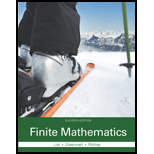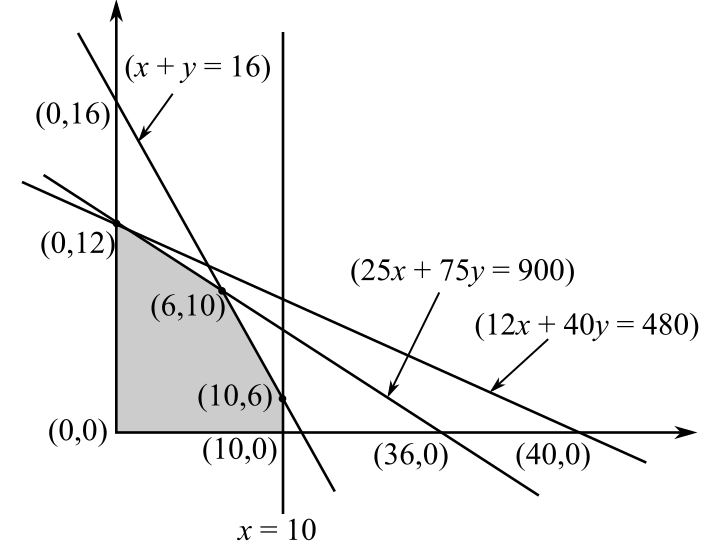
Concept explainers
Use sensitivity analysis to find the optimal solution to the original 4-H problem, if the profit from raising a goat increases from $12 to $25.
Answer to Problem 1EA
Solution: The new optimal solution is to raise 6 goats and 10 pigs.
Explanation of Solution
Given: The maximum number of animals raised at a time is 16. The maximum number of goats raised at a time is 10. The cost to raise one goat is $25, and the cost to raise one pig is $75. The maximum cost available to raise the animals is $900. The profit gained from one pig is $40. The profit increases from $12 to $25 for one goat raised.
Explanation:
The constraints as provided by the original problem are
The original objective function is
The graph of the linear inequalities as provided by the original solution is

The optimal solution of the original problem is at the corner point
Let the profit on one goat increase from $12 to $
The new objective function is
The slope of the isoprofit lines for this objective function is
The cost constraint inequality can be written as
The corresponding boundary line is
The slope of this boundary line is
The optimal solution changes from the corner point
The slope of this constraint line is −1.
Thus, the optimal solution changes from
The profit on one goat increases from $12 to $25.
Since c lies in the range
Conclusion: When the profit on one goat raised is increased from $12 to $25, the slope of the isoprofit lines changes such that the optimal solution changes from 0 goats and 12 pigs raised to the next intersection point of the provided constraints, which is 6 goats and 10 pigs raised because the profit margin increased on one goat raised makes it profitable to raise goats also.
Want to see more full solutions like this?
Chapter 3 Solutions
Finite Mathematics (11th Edition)
 Big Ideas Math A Bridge To Success Algebra 1: Stu...AlgebraISBN:9781680331141Author:HOUGHTON MIFFLIN HARCOURTPublisher:Houghton Mifflin HarcourtAlgebra & Trigonometry with Analytic GeometryAlgebraISBN:9781133382119Author:SwokowskiPublisher:Cengage
Big Ideas Math A Bridge To Success Algebra 1: Stu...AlgebraISBN:9781680331141Author:HOUGHTON MIFFLIN HARCOURTPublisher:Houghton Mifflin HarcourtAlgebra & Trigonometry with Analytic GeometryAlgebraISBN:9781133382119Author:SwokowskiPublisher:Cengage Elementary Linear Algebra (MindTap Course List)AlgebraISBN:9781305658004Author:Ron LarsonPublisher:Cengage Learning
Elementary Linear Algebra (MindTap Course List)AlgebraISBN:9781305658004Author:Ron LarsonPublisher:Cengage Learning


